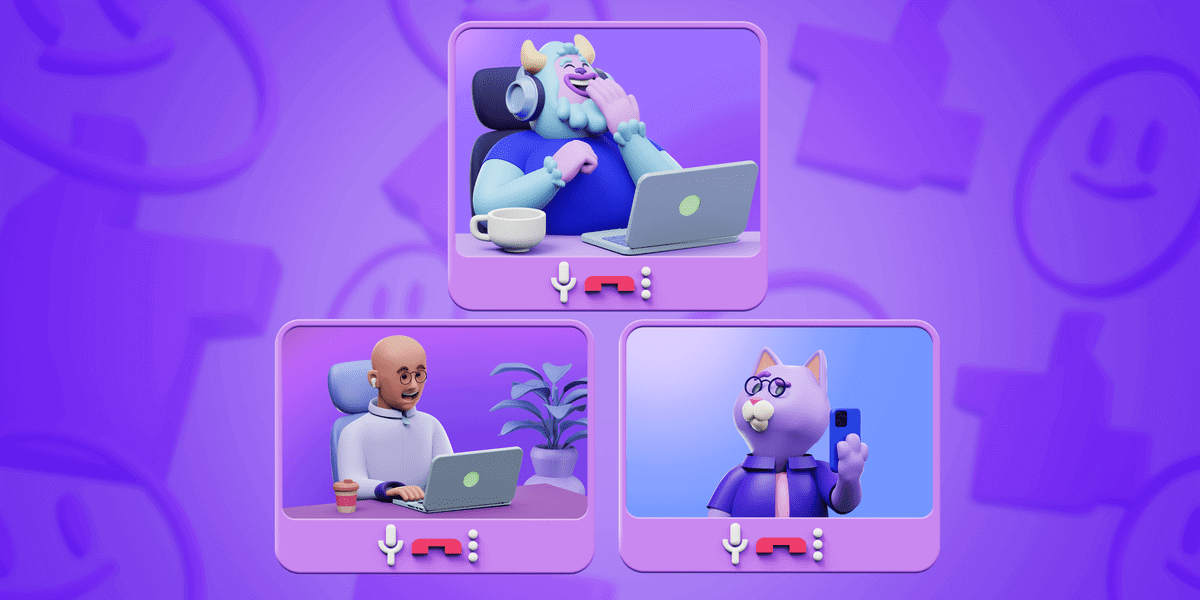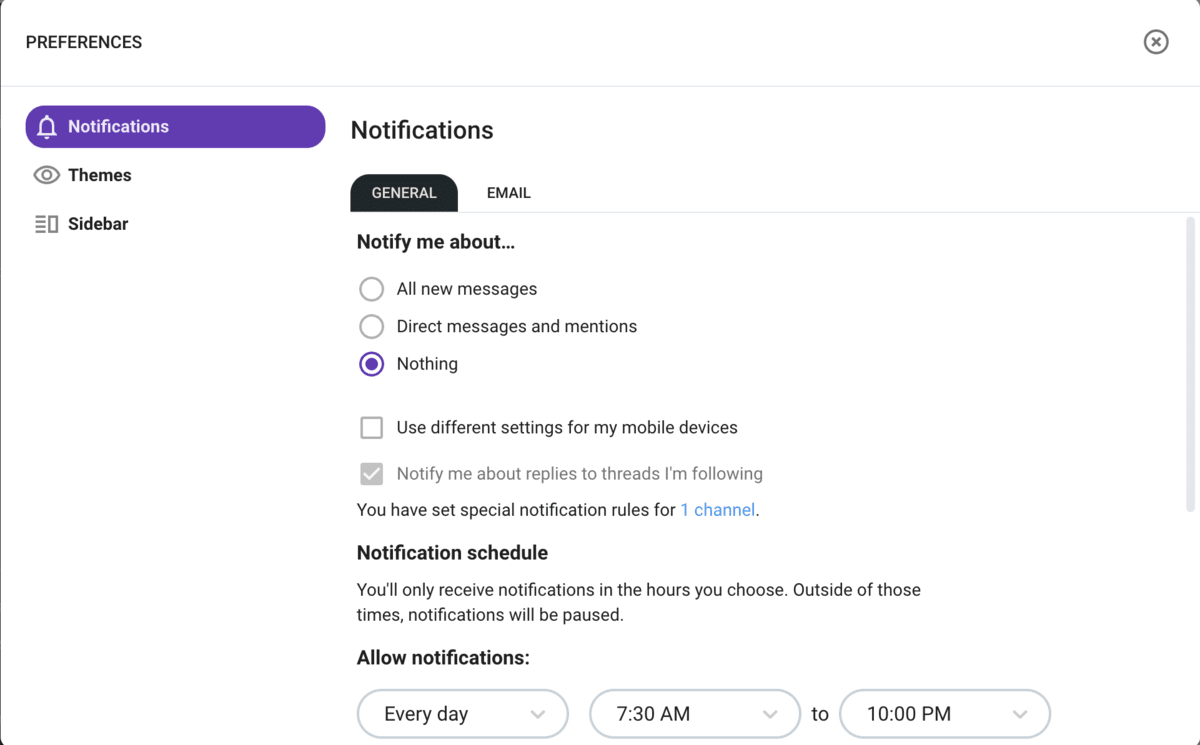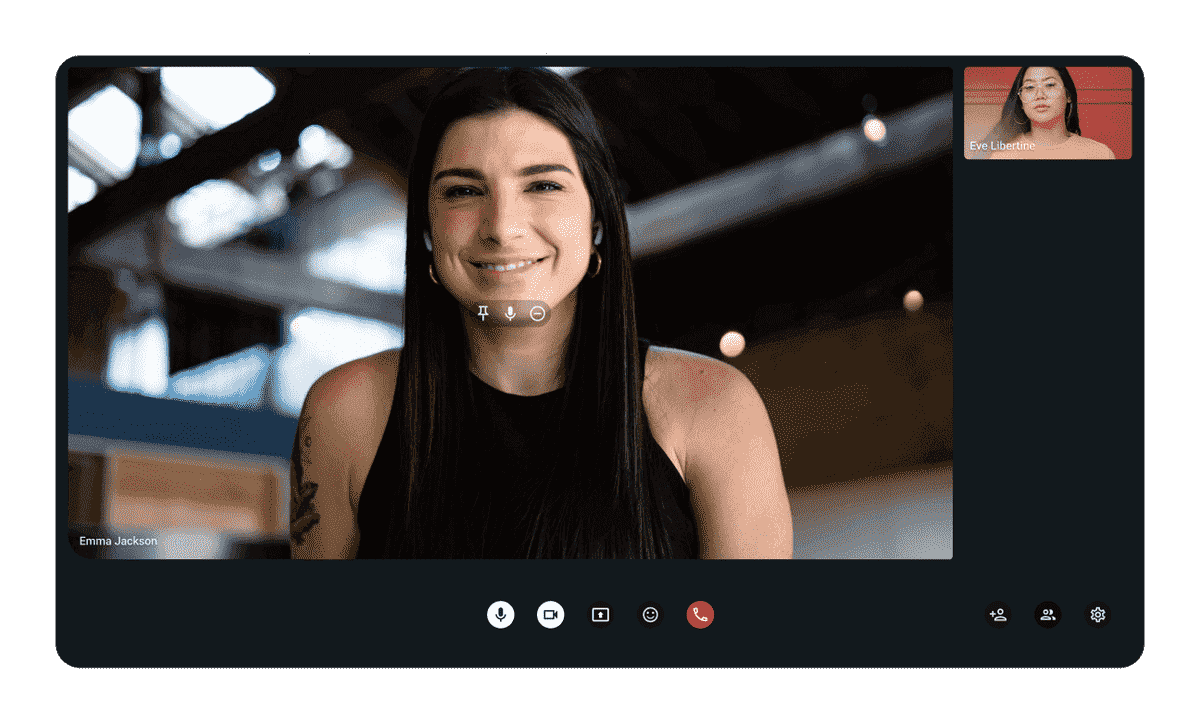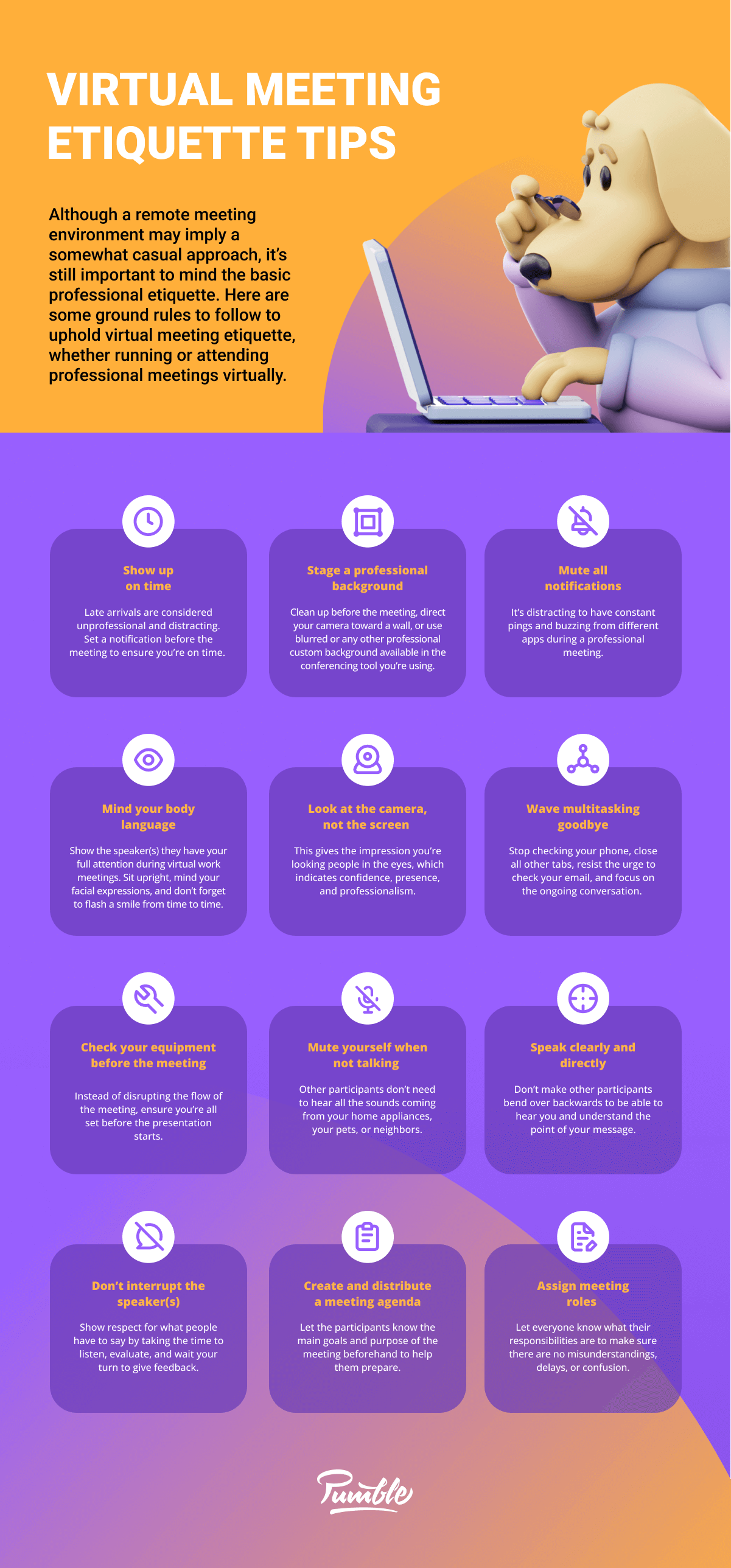We’ve all witnessed inappropriate behavior during virtual meetings at one point in our professional life, at least to some extent.
There’s often that one person that can’t keep it together, to the absolute shock and disbelief of others.
Whether they’re eating on a video call with their mic on, constantly interrupting others, or showing up late, it’s clear to everyone (but themselves) how distracting and downright rude this can look (and sound).
If you can’t recollect any of these situations and behaviors, it’s time you reassessed your behavior during meetings — because you could be the (inappropriate) person in question.
In all seriousness, understanding and applying good meeting manners is an important part of an effective and productive meeting experience/environment.
That is why this blog post will go over:
- The importance of meeting etiquette for virtual meetings,
- The 8 major points of virtual meeting etiquette, and
- Virtual meeting etiquette dos and don’ts.
Let’s get started!

Table of Contents
The importance of meeting etiquette for virtual meetings
Even though the virtual meeting environment introduces more flexibility and comfort, when it comes to meeting etiquette, essentially the same rules apply as for in-office meetings.
Etiquette in virtual (and in-office) meetings helps us become more aware of how our actions and words affect others. By fostering good manners and respectful behavior, we can achieve:
- More effective communication,
- Better collaboration,
- Faster goal achievement, and
- More connection overall.
However, as much as we would never be caught engaging in discourteous behavior in person, the virtual environment has seen some bad manners, to put it lightly.
This has especially been prominent over the past two years with the majority of companies and professionals adjusting to the virtual meeting environment. As expected, mistakes were made and some rules went out the window.
However, it’s time to start taking our meetings seriously and learn the ropes of proper virtual meeting etiquette.
What are the 8 major points of virtual meeting etiquette?
While every meeting is different in terms of its purpose, the number of participants, and the format it takes, there are several points that universally apply when it comes to basic etiquette for virtual meetings.
Point #1: Timing
In virtual meetings, as in life, timing is everything.
Professional business etiquette in general implies punctuality.
In the virtual meeting area, the timing aspect of etiquette translates to showing up to meetings on time. It also requires meeting organizers to:
- Schedule meetings ahead of time to give everyone enough time to prepare and
- Plan the timeline to avoid the scenario of going over the allotted time.
Point #2: Tools/platforms
Virtual environment introduced some new points to the meeting etiquette rules, one of which is most certainly the conferencing platform conundrum.
The type of conferencing platform or tool you use largely determines the success and professionalism of your video conferencing or voice calls.
An unreliable tool can jeopardize the privacy and security of your conversations and meetings, leaving a bad impression on your clients and damaging your team connection and communication.
Distractions, interruptions, and confusion are common scenarios with unreliable and/or complicated tools.
Moreover, a buggy tool can turn your meetings into a phone game where the initial message shared by the presenters has to go through the unreliable decoder, and you’re left to guess what’s being said.
Point #3: Preparation
Good meeting manners suggest making an effort to plan and arrange all sorts of details to ensure a pleasant, professional, and efficient meeting for all participants.
For the most part, the preparation aspect for virtual meetings includes the same elements as in-office meetings, the only difference being the format the two take place in.
For example, it’s considered common courtesy in both scenarios to put together a detailed meeting agenda that defines the purpose of the meeting and allows everyone to prepare properly. It also keeps the discussion on track and sets the tone of the meeting by giving participants a script to follow. A meeting agenda eliminates confusion and allows everyone to put their best foot forward in creating a productive meeting experience.
Another important element in meeting preparation is assigning the right meeting roles to ensure everyone is clear on their responsibilities during a meeting. Otherwise, meetings can turn into chaotic messes with improvised presentations, delays, misunderstandings, and interruptions.
💡 Pumble Pro Tip
Prepping for a major presentation at work and not sure where to even start? We’ve got a complete guide to help you ace your next presentation, be sure to check it out:
Point #4: Body language/appearance
It’s not really a groundbreaking discovery to say that our body language and general appearance play a major role in professional meeting etiquette.
However, while we all seem to intuitively know how to convey professionalism, respect, and good manners through our body language in in-office meetings, somehow this doesn’t always show in a virtual setting.
Of course, we can argue that plenty of nonverbal cues are lost in a virtual setting, however, there are still basic rules of etiquette that are still very much detectable, even on screen.
For example, if your posture is slouchy, it reads as being closed off, hostile, unfriendly, or that you’re hiding something.
At the same time, according to The Definitive Book of Body Language by Allan and Barbara Pease, openness and honesty are most accurately detected by open postures with palms showing.
These, like many other body language cues, are easily identified in on-camera meetings. Therefore, it’s important to understand them in order to demonstrate commitment to good meeting manners.
Point #5: Background
Our meeting backdrop is one of the meeting etiquette points closely related to the virtual meeting setting.
While we never had to pay any attention to our background during in-office meetings, remote meetings brought this aspect to the forefront in a major way. From messy rooms to funny virtual backgrounds — we’ve seen it all over the last couple of years.
And, as much as it brought laughter and brightened up some heavy discussions, we could often find ourselves getting distracted and secretly questioning these individuals’ professionalism.
This is why our background appearance plays an important role in our virtual meeting etiquette.
Later on, we will offer tips on how to ensure your background is always camera ready.
Point #6: Interruption policy
Interruptions are one of the trickiest elements to categorize and tackle when it comes to meeting etiquette.
While most of us would agree it’s considered rude and inappropriate to interrupt the speaker(s) in a meeting, at the same time, we understand there are instances where it’s simply necessary to do so.
This is why it’s paramount to devise a general policy on how to limit interruptions in meetings.
Otherwise, the conversations can go on a tangent and distractions can disrupt the flow of the meeting — which results in wasted time and loss of productivity.
Point #7: Communication
The way we communicate in meetings is another critical component of our meeting etiquette, and business communication etiquette in general.
Clarity, transparency, and directness in meetings show professionalism, commitment to problem-solving, and achieving common goals.
It also shows you respect other people’s time and energy so as not to put them in the position to suffer through long monologues that lead nowhere.
At the same time, the virtual meeting environment doesn’t always make this job any easier, therefore, it’s crucial that we pay attention to how our messages come across.
Point #8: Clear action points
Proper virtual meeting etiquette suggests delivering clear action points after the meeting ends to ensure everyone is clear on the next steps and responsibilities.
Failing to provide clear action points after a meeting defies the entire purpose of the meeting. As a meeting organizer, you’re leaving participants to fend for themselves and rely on their memory alone when figuring out their next steps and responsibilities, which is considered unprofessional and lazy.
Virtual meeting etiquette dos and don’ts
Now that we’ve covered major points of virtual meeting etiquette, it’s time we break them down into actionable tips we can apply.
Let’s take a closer look at our top virtual meeting etiquette tips to follow for professional and effective virtual meetings.
Do assess if the meeting is necessary
First and foremost, before you even start creating a meeting plan, ask yourself whether that meeting could have been an email or a thread in a team communication app.
According to meeting statistics, professionals report spending 8% of their work week on meetings that are unproductive, which largely disrupts regular workflow for over 60% of respondents.
To ensure you’re making an informed decision, you can create a simple checklist to help you assess faster.
A good way to start is to assess for things like:
- Urgency of the matter,
- The purpose of the meeting,
- The number of people responsible, and
- The amount of time you have to organize a meeting.
Don’t invite too many (irrelevant) attendees
Unnecessary meetings are a major waste of time, so make sure you don’t overwhelm people with discussions they have no stake in taking part in.
A good rule of thumb is to apply the 8–18–1800 rule when deciding. Here’s how you can apply this rule according to the book Running meetings by Harvard Business School Press:
- Invite a maximum of 8 people to meetings when you need to make a decision or solve a problem.
- For brainstorming sessions, you can invite up to 18 participants.
- Meetings that involve updates from all participants can be also limited to 18 participants, whereas meetings where only one person needs to share updates need not have an upper limit to the number of participants (as long as all the people invited need to receive the updates).
- All hands meetings and situations where you need to rally the troops can include 1,800 participants — or however many people you deem relevant.
Do show up on time
Our next virtual meeting etiquette tip is a no-brainer if we ever saw one.
Still, it’s an important reminder for all of you that a little bit goes a long way in terms of showing respect and professionalism in work meetings.
All it takes is setting up a reminder to show up a few minutes early, get in the meeting frame of mind, and while you’re at it, check if all the tools and the Internet are working properly.
Don’t leave before the meeting ends
Being the first person that leaves before the meeting officially ends will get you the wrong kind of attention.
In addition to showing bad meeting manners, you’re also missing information or decisions that might be critical to your work.
In case there’s an emergency or another work call you must attend, be sure to message the meeting organizer directly or send an instant message to everyone on chat so as not to disrupt the ongoing conversation.
Do plan time estimates
If you’re in charge of organizing the meeting, consider putting time estimates for each discussion point or task in your meeting agenda.
This way, you’re allowing participants to understand how much time is allotted for each point roughly and plan their time accordingly.
When in doubt — keep it short. Respect people’s time and be mindful of their virtual time bandwidth. Let’s not forget the infamous zoom fatigue and the terrible toll it can take on people’s physical and mental health.
Don’t go over the time allotted
Once you’ve planned your timeline, make sure to stick to it and ensure your meetings are not going on longer than planned.
If you’re a participant, you can demonstrate your awareness and respect towards other people’s time by making sure to offer your update concisely.
Do schedule in advance
To show you’re mindful of others’ time and workload, always make sure to schedule your meetings days ahead of time. This gives participants enough time to prepare and plan their schedules.
In case you need to schedule impromptu one-on-one meetings or small group calls, consider adding a detailed description to the meeting invite to give everyone a proper outline of expectations and responsibilities.
Don’t schedule back-to-back meetings
As mentioned above, virtual on-camera meetings are draining our mental and physical energy, leaving us exhausted and oftentimes unable to keep up with our daily workload.
Imagine then what an entire day of back-to-back meetings is doing to our mind.
While you can’t necessarily solve this problem entirely, you can help take the edge off the mental load for people.
Whether you’re the one planning and organizing meetings or a participant, be sure to plan for at least a few minutes in between meetings to help everyone recharge and reset.
Do pick the right communication software
An intuitive and easy-to-use video conferencing tool will decrease confusion and distractions and allow for a productive and collaborative meeting environment.
Here are some important features to look for in a virtual meeting tool to ensure proper virtual meeting etiquette is maintained:
- Intuitive user interface — To allow your team to sign up and join calls in one click without having to follow detailed guidelines. This way, you’re limiting confusion, delays, or late arrivals.
- Generous participant capacity — To promote an inclusive and transparent meeting experience for all participants.
- Flexible screen sharing options — To ensure participants can feel comfortable sharing during meetings and improve inclusivity for people joining via mobile phones, for example.
- Audio and video call settings and reactions — To control roles and permissions and facilitate a distraction-free environment.
Instead of going for the most popular (but often complicated and clunky) options on the market, consider doing more thorough research into more cost-effective and user-friendly alternatives.
Don’t ask if everyone can see your screen
It may seem like the most reasonable thing to do if you’re presenting in a virtual meeting. However, most people consider it rather annoying and distracting.
Instead, you can say something along the lines of:
“Unless someone interrupts me, I’m going to assume that everyone can see my screen.”
Moreover, to ensure you don’t disturb the flow of the meeting, you can check all your equipment, apps, settings, and Internet connection to make sure you’re all set before you start presenting.
Do mute all notifications
It’s distracting to hear all the pings and buzzing coming from different apps during a professional meeting.
As a meeting participant, you can do your part in creating a more enjoyable and distraction-free environment for everyone, by simply putting all notifications on mute during the meeting.

Don’t keep your mic on if you’re not talking
Other participants don’t need to hear all the sounds coming from your home appliances, your pets, or neighbors. It’s unprofessional and distracting.
So, show you’re mindful of how your actions affect other meeting participants, and always make sure to keep your microphone muted when not talking during a meeting.
Do create and distribute a virtual meeting agenda
If you’re in charge of organizing the meeting, it’s not only a sign of good meeting manners but your responsibility to prepare and share a virtual meeting agenda.
Having participants know the main goals and purpose of the meeting beforehand helps them join the meeting with a better understanding of the purpose of the meeting.
The meeting agenda also serves to set the tone of the meeting so people don’t have to improvise or feel insecure.
💡 Pumble Pro Tip
If you want to make sure your meeting agenda aligns perfectly with the virtual meeting environment and the demands and challenges it poses, check out our blog post that dives deep into this topic:
Don’t improvise
Your work meetings are not a comedy bar.
Whether you’re a participant in charge of attending and taking part in the discussion or an organizer responsible for getting everyone engaged in the discussion, it’s more than common courtesy to at least go over the meeting agenda and prepare for major talking points.
Do assign meeting roles
Meetings without clear roles can turn into a chaotic mess of misunderstandings, interruptions, and confusion.
If you’re in charge of organizing the meeting, mind your meeting manners by assigning clear roles and responsibilities so people can:
- Get their voices heard,
- Collaborate more effectively, and
- Feel more comfortable and motivated to engage in discussions.
💡 Pumble Pro Tip
If you’re not sure which roles are essential for productive and professional virtual meetings, we have a blog post that might help you:
Don’t push the roles onto people who don’t feel comfortable or qualified
While it’s important to assign key meeting roles to ensure maximum productivity and professionalism, it’s equally important to assess if you’ve picked the right people for the role.
A new intern won’t feel comfortable facilitating a board meeting with important clients, the same way a team member who is experiencing meeting anxiety won’t be successful in a Chair/Leader role in a meeting.
In addition to making everyone feel extremely uncomfortable, these decisions can also ruin your brand image and reputation with clients.
Do mind your body language
Ever caught yourself or your teammates nodding in agreement to a statement someone had made in a virtual meeting?
Do the serious faces during a presentation make you nervous and worried you’re doing something wrong?
These are all proof that non-verbal communication plays an important role in our virtual meeting etiquette.
To show the speaker(s) they have your full attention during virtual work meetings, be sure to mind the basic professional body language etiquette rules:
- Sit upright facing the camera,
- Mind your facial expressions, and
- Don’t forget to flash a smile from time to time.

💡 Pumble Pro Tip
To get more tips on how to display professionalism, respect, and engagement through body language in virtual meetings, check out our blog post:
Don’t look at the screen
The basic virtual meeting etiquette states you look directly into your camera, and not the screen.
This can be weird at first and takes practice to become second nature, but it’s one of the most important (and often overlooked) elements of virtual meeting etiquette.
Keep this tip in mind especially if you’re speaking in a meeting — this gives the impression you’re looking people in the eyes, which indicates confidence, presence, and professionalism.
Do wave multitasking goodbye
Thinking you can grab a quick snack during longer meeting presentations? Better think twice.
Eating during meetings is not only seen as distracting, but it’s downright rude and unprofessional.
The same goes for phone calls, texting, or checking your email during meetings.
Multitasking is not only seen as distracting and unprofessional by others, but it’s also counterproductive. Namely, studies have found that it actually increases the risk of mistakes..
A good rule of thumb when assessing your meeting manners in a virtual environment is to think whether a certain behavior would be appropriate in in-person meetings.
Don’t fidget or move around during on-camera meetings
Again, as we mentioned in the previous point, think how awkward it would look if you started moving around or rocking back and forth during an in-office meeting.
Therefore, it’s safe to say that this behavior is not appropriate in virtual meetings. It’s distracting and unprofessional.
If there’s an urgent matter and you have to move to another location, be sure to turn off your camera before you do so.
Do dress professionally
Another terrible trend we’ve seen in the first years of the pandemic and working from home was the overly nonchalant approach to how we dress for virtual meetings.
Although a virtual meeting environment often implies a somewhat casual approach (especially when it comes to how we dress), virtual meeting etiquette still mandates looking the part when attending work meetings. You don’t necessarily need to go all strictly corporate, but try to swap your pajamas for something more semi-formal, and you’ll be good to go.
Don’t overlook the importance of good lighting
No matter how sharp and smart you dress or polish up for a meeting, if your lighting is off, you’re most certainly going to leave a bad impression.
Poor lighting defies the entire purpose of on-camera meetings — if people can’t see you clearly, you might as well turn off your camera entirely.
That being said, you don’t have to splurge on studio lighting to be able to uphold virtual meeting etiquette.
Take a couple of minutes before the meeting and test the natural lighting in your room. Move closer to the window, or adjust your desk lamp to ensure proper lighting. Alternatively, you can adjust the lighting in your conferencing tool settings if it’s supported in the app.

Do state when video will be used
As a meeting organizer and a mindful host, it’s considered common courtesy to inform the participants if the meeting will require video conferencing.
This eliminates any overthinking for participants and gives them a heads-up to be camera ready.
You can specify these details in the meeting agenda or share it in the meeting invite description.
Don’t forget to stage your background for video
We can all agree it’s highly unprofessional and distracting to have a messy room showing behind you in a work meeting.
To avoid this scenario, be sure to:
- Set aside a few minutes before the meeting to clean up.
- Direct your camera toward a wall.
- Set blurred or any other professional custom background available in the conferencing tool you’re using.
Do think twice before you interrupt
Interruptions are at the top of the list of the most disruptive meeting behavior, according to aforementioned meeting statistics. And one of the most common ones, we would add.
Still, it’s rarely considered appropriate to interrupt in a meeting.
If you don’t want to be perceived as a person who lacks basic virtual meeting manners, remember to brace yourself next time you feel the urge to press that mic button and cut in.
Unless you need to provide an urgent and super-relevant update. In that case, remember to raise your virtual hand first (so as not to disrupt the ongoing conversation), and wait until you’re given permission to jump in.
💡 Pumble Pro Tip
If you’re not sure whether it might be fine to chime in during a meeting, and how exactly to go about it, check out our guide on the blog:
Don’t let the conversations get sidetracked
While it’s mostly considered impolite to interrupt in a meeting, there are some instances where it might be necessary to cut in — especially if you’re in charge of facilitating the meeting.
One of the most common situations where interruptions are not only appropriate but mandatory is when you notice a conversation going on a tangent. Irrelevant and off-topic conversations are major time-wasters in meetings, so it’s best to nip them in the bud, respectfully.
Do speak clearly and directly
Don’t make other participants bend over backwards to be able to hear you and understand the point of your message.
Meetings are also no place to speak in riddles or beat around the bush, so make sure to get your message across loud and clear.
Direct communication leaves no room for misinterpretation or confusion, and it’s time-efficient, which is exactly the effect you want to achieve.
Moreover, by speaking clearly and unambiguously, you’re showing respect to other meeting participants, which is another essential item on the list of good meeting manners.
So, remember to speak up and share your point of view directly and concisely in a virtual work meeting.
💡 Pumble Pro Tip
To learn more about how to speak directly while remaining polite, be sure to check our guide on the blog:
Don’t forget to leave room for questions
No matter how clear and direct you might think your presentation is, there’s always room for clarification.
To demonstrate your commitment to upholding virtual meeting etiquette tips, be sure to allow enough time (and energy) to answer any questions and clear any misunderstandings at the end of the meeting.
Do keep and distribute meeting minutes
Just like meeting agenda serves as a structure during a meeting, meeting minutes offer a perfect outline for post-meeting activities.
Proper virtual meeting manners suggest making sure all relevant information exchanged in a meeting gets to the people responsible for implementing the next steps.
💡 Pumble Pro Tip
To learn the ropes to writing meeting minutes, be sure to check out our guide on the blog:
Don’t close the meeting without a recap
It’s considered common courtesy to close a meeting with a quick overview of the main points, decisions, and action items.
In addition to serving as a great reminder of assigned responsibilities, a meeting recap serves as a polite and professional way to thank everyone for joining and offer a virtual handshake and a goodbye.
That being said, here’s a recap of all dos and don’ts we’ve discussed:
| ✅ Virtual meeting etiquette dos: | ❌ Virtual meeting etiquette don’ts: |
|---|---|
| Assess if the meeting is necessary. | Invite too many (irrelevant) attendees. |
| Show up on time. | Leave before the meeting ends (unless it’s an emergency). |
| Plan time estimates. | Go over the allotted time. |
| Schedule your meetings in advance. | Schedule back-to-back meetings. |
| Pick the right communication software. | Ask if everyone can see your screen. |
| Mute all notifications. | Keep your mic on if you’re not talking. |
| Create and distribute a meeting agenda. | Improvise. |
| Assign meeting roles. | Push the roles onto people who don’t feel comfortable or qualified. |
| Mind your body language. | Look at the screen. |
| Wave multitasking goodbye. | Fidget or move around during on-camera meetings. |
| Dress professionally. | Overlook the importance of good lighting. |
| State when video will be used. | Forget to stage your background for video. |
| Think twice before you interrupt. | Let the conversations get sidetracked. |
| Speak clearly and directly. | Forget to leave room for questions. |
| Keep and distribute meeting minutes. | Close the meeting without a recap. |
Show your manners over Pumble
Regardless of how comfy and casual your remote workspace may seem, it’s still very much part of your official work life. Therefore, you have to start showing the same amount of professional awareness in the virtual meetings as you would display onsite.
Now all you have to do is put the tips we gave you in practice — and the best way to do that is over Pumble.
A communication and collaboration tool, Pumble, allows you to:
- Schedule meetings in advance straight from your calendar,
- Distribute the meeting agenda in a dedicated channel or group direct message,
- Easily share your screen with all the participants, and
- Mute notifications during the meeting, so you remove all distractions.




